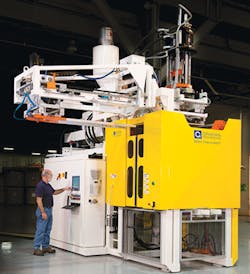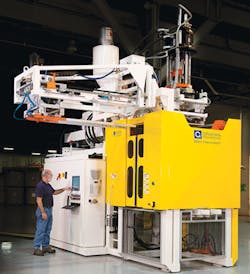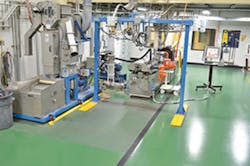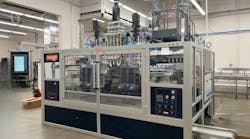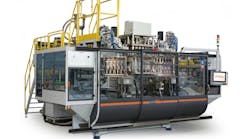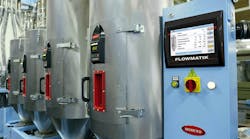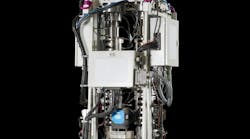Manufacturers of primary processing equipment are building better safety features into their machines to combat some common safety risks that can lead to injuries, as well as other risks that are unique to particular processes.
The good news is that safety standards provide strong guidance for the industry. Chuck Flammer is VP of sales for Kautex Machines Inc., North Branch, N.J., and chairman of the Blow Molding Safety Subcommittee of the Plastics Industry Association, an ANSI-accredited standards developer. He said arriving at some commonality of safety standards affecting the various types of plastics machinery is a long-term goal. That would simplify compliance by machinery manufacturers.
On the technology side, better controls and effective safety devices both inside and outside the machines are making them safer. Risk assessments are key to making sure that the machines delivered to customers will meet the safety requirements in the plant. Of course, even the best safety features on the machine can only go so far in ensuring safe operation, and safety training is crucial to avoiding injuries.
WHAT ARE THE BIGGEST SAFETY RISKS?
Those interviewed identified areas on their machines that are potential safety risks, as well as safeguards for preventing injuries. Justin Kilgore, VP of engineering at Graham
Engineering, said that the product that the customer is producing and the manner for producing it are considerations for the setup of safety equipment around a particular machine. On a blow molding machine, for example, a semi-automatic insert-molding process would have different safety requirements than a fully automated blow molding process, he said.
Jim Pilavdzic is manager of product safety at Husky Injection Molding Systems Ltd., Bolton, Ontario. In injection molding, the most common preventable injuries involve hot plastic spray. Common injuries occur in the purge guard area and the hopper area of an injection molding machine, he said. Other common preventable injuries occur due to removal of the fixed guard during the maintenance and setup of the machine. "Well-designed machinery should not require any guard defeat or removal in order to be properly operated or maintained," he said.
Per Genendsch, the electronic group leader at thermoforming machine supplier Gabler Thermoform GmbH & Co. KG, Lübeck, Germany, said common injuries are burns from radiant heaters. Also, the fast movements of the press pose a safety risk. He noted that on his company's machines, the movements cease and the heater is moved back to a safe distance when the operator opens the doors to the press.
In the blown film process, the biggest safety risks are with the winders, said Andrew Wheeler, president of Windmoeller & Hoelscher Corp., Lincoln, R.I. "Any time there is a moving part in the line, you have to eliminate pinch points and eliminate areas where operators can get something caught and be pulled into the machine," he said.
Safety devices such as light curtains on winders allow an operator to safely check the film quality of a roll. In addition, extruder barrels are cladded to prevent exposure to hot surfaces, and cladding also covers cables to minimize tripping hazards.
Wheeler also noted that older machines that do not meet current safety standards encourage unsafe practices by machine operators. One example: injuries related to roll cutovers, when it is time to change over to a fresh roll. Injuries have resulted from doing cutovers manually using an open blade, because either the machine has no automatic cutover system or the system was not functioning, he said. While most winders have automatic cutover for safety reasons, there are many older blown-film lines still operating that do not.
Older equipment that is not up to current safety requirements presents risk. Flammer said that current safety standards are much more strict regarding older machines than they have been in the past.
SMARTER CONTROLS PROVIDE BETTER SAFETY
In the view of Husky's Pilavdzic, improvements in safety controls are accelerating. Newer machines have highly sophisticated safety PLCs and safety devices. Position sensors are now being coded and individually monitored for performance.
Matt Ramsdell, electrical engineer for Entek Extruders, Lebanon, Ore., agrees. He said that his company's extruder controllers perform internal checks and provide more information about component failures than analog meters have in the past. Entek has developed its own HMI that is interfaced with the PLC outputs. As a safety feature, the HMI allows different levels of security for supervisors, maintenance personnel and operators. For example, enclosures around the electrical equipment are locked, providing access to only supervisory or maintenance personnel.
Rob Kraybill, an electrical engineer with Graham Engineering Corp., York, Pa., said the industry is moving away from electro-mechanical safety relays based more on ladder logic and individual electrical connections, and toward the use of safety PLCs. He added that with the diagnostics available on machines today, it's much easier to understand what is broken.
One advantage of the trend, he said, is that machine information is provided right at the HMI or the operator station. This setup means that when something goes wrong, maintenance workers don't have to open a panel door and read the machine status from a safety relay, which reduces the safety risk to them. If you provide that feedback, operators and maintenance workers are much less likely to try to bypass the safety system, he said. "We make it easy for the operator to work with the machine [rather] than against it." He added that safety PLCs make it easier to implement safety devices such as light curtains.
Kilgore noted that the safety PLCs used on Graham Engineering's blow molding machines are PC-based technology, which he classifies as a "soft PLC." He said the safety PLC quickly and clearly provides diagnostic information to the operator about which safety devices have failed or tripped. If an emergency button is pushed to halt the machine's operation, it's easy to see which emergency stop, or E-stop, button has been activated and where the E-stop is located on the HMI screen, he said. According to Kraybill, soft PLC technology has been well-vetted and matches the performance level of hard-wired safety relays.
He added that the soft PLC technology used by Graham Engineering is modular. "It is really a distributed-type system," he said. A large accumulator-head blow molding machine or large rotary-wheel blow molding machine could have as many as 10 E-stop buttons mounted across the entire machine. Typical safety relays would require wiring each E-stop to the single-panel, main safety relay. The modular system is much more efficient from a wiring standpoint, he said.
REDUNDANCY PROVIDES SAFER MACHINE OPERATION
Manufacturers are using redundancy to ensure that the safety systems on their machines are more reliable. E-stops in the past used a single wire connection, Kraybill explained. "We found that if that wire gets pinched or shorted, the E-stops became nonfunctional even though nobody realized it," he said. "Now you have two channels, and you have to have those two wires do the same function in a certain amount of time. Redundancy provides another level of safety."
Ramsdell noted that Entek uses redundant temperature probes on its heat controls, one to control the heat and the other to monitor the temperature. In case one fails, the other can take over until the first can be repaired, he said. Redundant temperature controls are important because if a probe is reading the temperature in a heating zone to be cooler than it actually is, the barrel can overheat and possibly cause a fire. "Redundancy works well, because usually only one will fail in a particular zone, but not both," he said.
Husky's Pilavdzic gave an example of how redundancy has improved safety in the mold area of injection presses. The mold area guarding, such as the operator's gate, is interlocked with a minimum of two independent safety circuits, he said. The first safety circuit uses two electrical position sensors activated by the operator gate. The act of opening the operator's gate changes the state of the limit switches, so that if one of the position sensors is defeated, the machine's safety monitoring will recognize this and shut off the machine immediately. The second safety circuit is in the main power circuit; in a hydraulic machine, this would be a monitored safety shut-off valve, often called CEN valve. The opening of the gate will shut off supply of the hydraulic oil to the clamp-closing cylinder of the machine and prevent the clamp-closing motion, thereby preventing a crushing hazard in the molding area.
John DeGaspari, senior correspondent
Contact:
Entek Extruders, 541-259-1068, www.entek.com
Gabler North America, 989-615-6365, www.gabler-thermoform.com
Graham Engineering Corp., 717-848-3755, www.grahamengineering.com
Husky Injection Molding Systems Ltd., 905-951-5000, www.husky.co
Kautex Machines Inc., 908-252-9350, www.kautex-group.com/us-us
Windmoeller & Hoelscher Corp., 401-333-2770, www.whcorp.com/us
